In the previous chapters of this series we have mostly concentrated on using nothing but chord tones, with the exception of some leading tones to spice things up a bit. The main purpose of working with these ideas is to get yourself familiar with, and being able, to find chord tones quickly.
For most songs, especially where all, or most, of the chords all belong to the same key, we’ll often use scales for our solos. Knowing how to make use of chord tones will greatly improve our playing when using scales because it helps us get away from thinking purely in terms of scale patterns where we might tend to just noodle around scale notes with no direction.
I covered the basic theory of chords and scales belonging to a common key in Part 3 – and why using the “correct” scale doesn’t necessarily mean we can just play any scale note we like and expect it to fit over any of the chords.
Using pentatonic scales can make things a little bit easier for us. With only five notes as opposed to the seven used in the major scale, we have slightly less chance of hitting bad sounding notes. This doesn’t make the pentatonic scale any less usable or amateurish, sometimes it’s just the right scale for the job. It also doesn’t make it infallible to playing bad notes, but the chances are much lower. Either way, the point here is don’t underestimate the pentatonic scales, they define a lot of music styles and are used by just about every genre of musician.
A quick recap on the chords used in our ukulele style backing track are: C, Dm, Em, F, G, Am (not in the order of the song). All of these chords belong to the key of C major so we can use the C major scale or C major pentatonic. One of the biggest problems for beginners or the less experienced with using major scales, in my opinion, is there are too many notes to run wild with. When we start out with this stuff we find a scale diagram, run up and down the scale patterns and try to make it sound like music. This is actually hard work if we don’t have a lot of experience or much ear training – all we have is a bunch of chords and a scale pattern so we tend to just noodle aimlessly around the scale, picking out notes almost at random.
Obviously we have to start somewhere so it isn’t all bad, after all, it’s how we gain our experience. What we are going to do now is take a look at some other ways we can use the pentatonic scales. I’m not going to show you all of the usual 5 box patterns that everyone else teaches, there’s no need for me to repeat it here, it’s all over the Internet and you can look up the box patterns here on my website. For now we’re just going to look at two pentatonic scale diagrams, one with the root on the 6th string and the other with the root on the 5th string.
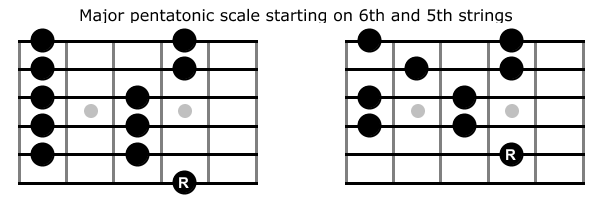
Let’s try playing a simple pentatonic riff over a I-IV-V backing track (in C major) but instead of just using C major pentatonic over the whole thing, we’ll use C major Pentatonic over the C chord; F major pentatonic over the F chord and G major pentatonic over the G. These are the pentatonic patterns we’ll use.

Here’s a simple riff played over the chord changes using the three scales.
Why use three pentatonic scales and why does it work? Well, ordinarily I might just stick with the single C major pentatonic over the whole thing – but I’ve used the three scales here to illustrate a point. I’m still using nothing more than the C major scale, but now I’m organising things a bit better. Let me explain…
When all of the chords belong to the same key, we can use pentatonic scales for each chord, apart from the diminished (vii) chord, and still not stray from the key. We can see why this works if we break down the scale and chord notes. I mentioned some of this in Part 3 but let’s take another look.
C major scale:
C, D, E, F, G, A, B
Chords in the key of C major
C E G = C major
D F A = D minor
E G B = E minor
F A C = F major
G B D = G major
A C E = A minor
B D F = B diminished
Notes in the pentatonic scales
C major pentatonic: C D E G A
D minor pentatonic: D F G A C
E minor pentatonic: E G A B D
F major pentatonic: F G A C D
G major pentatonic: G A B D E
A minor pentatonic: A C D E G
As you can see, none of the notes in any of the scales go outside of the C major scale. What’s more, each of the pentatonic scales contain the triad notes of the associated chord. This means we could use pentatonic scales in this way while minimising the odds of hitting clashing notes with the underlying chord.
All of this is just a point of interest worth taking note of – it doesn’t necessarily mean it will always sound good but you should experiment with the idea. In my opinion, it works OK over this ukulele style track if used sparingly. Do this over a blues track and it will probably sound wrong. Do it over a country or bluegrass track and it will probably work very well – “probably” being the key word here. We don’t need to be able to magically detect when something is going to work well or not, sure we’ll get better at it with experience but a lot of the time we’ll just try something, decide we like it, or don’t, and react accordingly. Either way, you should practise these kind of things because it just gives you more options for creative ideas.
Let’s look at another way we can incorporate the pentatonic. C major pentatonic consists of five notes: C, D, E, G, A. The E form C major chord at the eighth fret already has the notes C, E and G. If we add the A and D to it then we end up with the C major pentatonic, something like this.
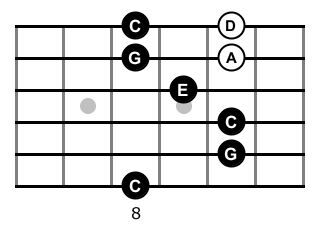
Sticking with our first four strings idea, we end up with this pattern
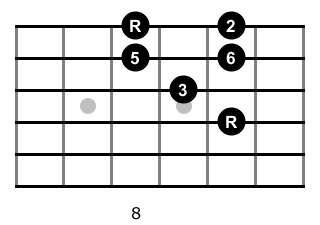
If we wanted we could simply move this pattern around to fit over each chord – 8th fret for C, 1st fret for F and 3rd fret for G. Here’s the basic idea.
When we play a guitar solo, all we’re really doing is piecing together ideas that we’re familiar with. There’s hundreds of ways you could tackle a guitar solo but essentially it’s just a collection of things you’ve spent so many times practising and experimenting with that they become second nature. What we’ve looked at in this series is just a bunch of fairly simple ideas that we could use to move around the fretboard, small scale chunks and chord tones that mostly compliment the underlying chord.
The more you do this the quicker you will get away from thinking about scales as just a set of notes grouped into a fixed pattern. Keep everything simple while you are learning, it’s far more important to have a simple solo that fits the backing than to rip up and down the neck at lightning speed just because it looks impressive.
The following TAB just shows a simple solo over C, F and G using an almost random mix of chord tones and major pentatonic scales. It’s nothing special but it works and it doesn’t sound like somebody just playing around with a scale pattern. The more you do this stuff, the better you will get at it. It takes time so just keep at it and eventually you’ll start to see the fretboard in a very different way. Have fun!
Go to: Part 1 . . . Part 2 . . . Part 3 . . . Part 4 . . . Part 5
Don’t forget, if you’ve got any questions just ask in the comments.

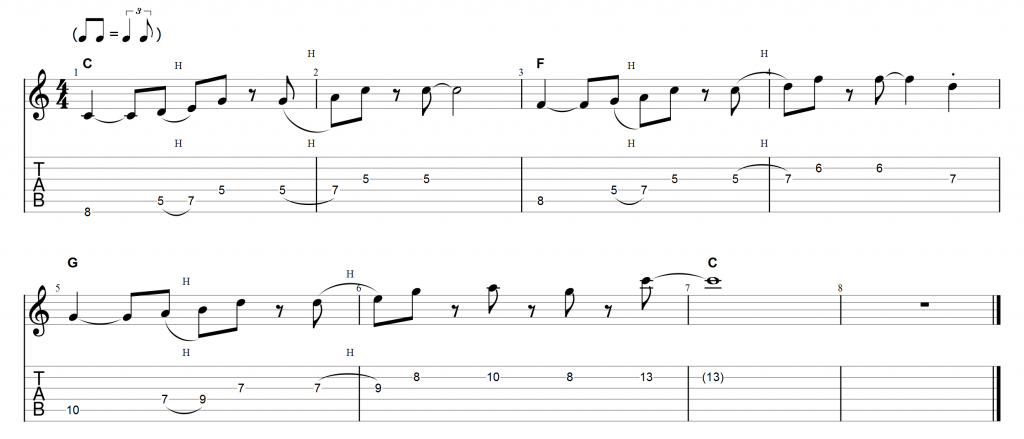
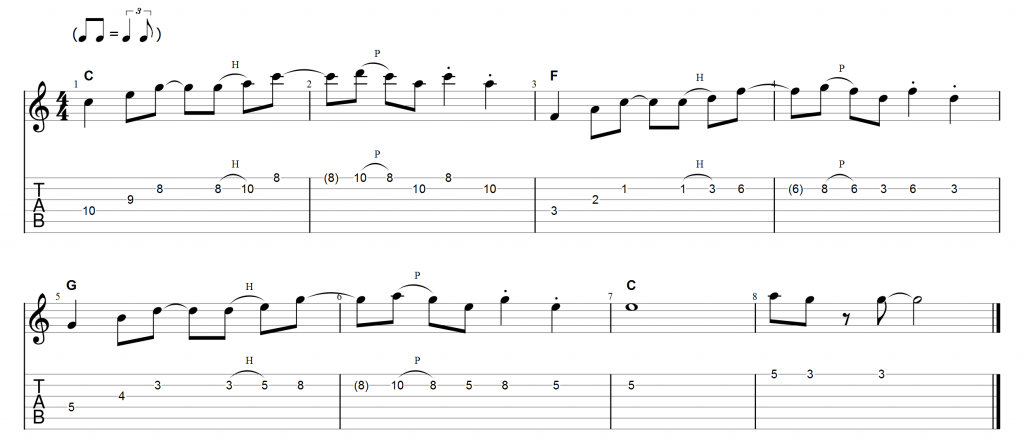
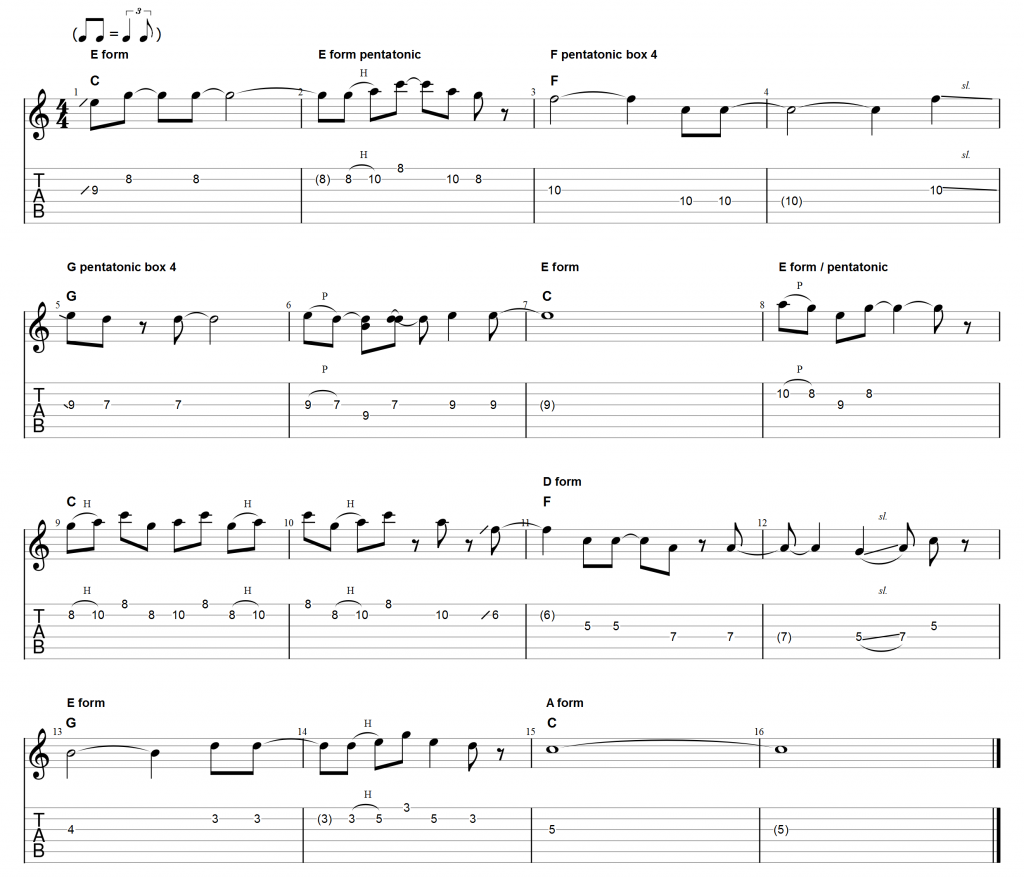

Wow Lee, I am familiar with this part of the series!
Hi Lee,
Had a good look through the CAGED System and Chord Tone Soloing Parts 1 to 5 along with Rock and Roll Soloing Parts 1 and 2 after purchasing your book, which I have had my eye on for some time. Both the book and the above lessons are full of interesting, useful information, delivered in a practical, straight forward, easy to understand user friendly manner.
Great stuff Lee, I reckon you could publish the above two lessons in book format and sell plenty of them, particularly to old farts like myself who prefer to hold pulp, recycled of course, in their hands rather than the modern tablet / laptop computer equivalent.
Sent
Thanks Timbo.
I could do that but I like to have free stuff on the website, keep a good balance.
Great stuff….
Thank You,
Willabe
Fantastic Lee!!!
I have your book, which I think everyone will benefit from – it taught me so much, and in an interesting way.
You have a great ability when it comes to teaching.
Frank.
Hey Frank, thank you, that means a lot to me.